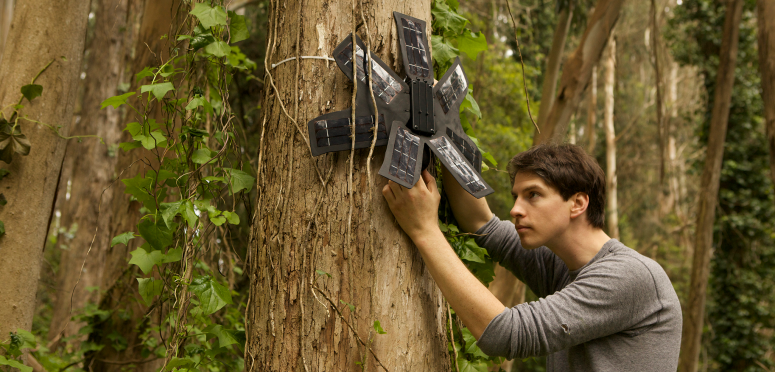Guardian of the Forest

Topher White '04 demonstrates installation of a Rainforest Connection device. In reality, the devices are hidden high in tree canopies.
From Kenyon News - January 3, 2017
If a tree falls in the forest and no one’s around to hear it, how do you stop illegal logging? This is a real problem in the world’s rainforests, where the buzz of chainsaws often is drowned out by the cacophony of nature.
Topher White ’04 is helping to solve the problem by converting recycled cellphones into the world’s first audio-based system to detect illegal logging. He founded the non-governmental organization Rainforest Connection in 2013 to deploy his system in protected rainforests in Sumatra, Indonesia; the Amazon and parts of Africa.
Powered by bits of recycled solar panels, the phones are mounted on trees where they “hear” chainsaws and other suspicious noises up to a kilometer away, then transmit real-time alerts to responsible agents on the ground.
The phone is housed within a protective box, and solar panels arranged around the box like flower petals catch what little sunlight streams through the tree canopy.
In 2015, National Geographic named White one of its Emerging Explorers, an honor bestowed upon “uniquely gifted and inspiring explorers already making a difference early in their careers.” His TEDx talk posted in March 2015 has received about 1.3 million views so far.
A physics major at Kenyon, White won the E. Malcolm Anderson Cup, the College’s highest honor for “the student who has done the most for Kenyon in the past year.”
White recently spoke by phone from his home in San Francisco about the Rainforest Connection and the role Kenyon played in his career.
How did you come up with the idea of using old cellphones to protect the rainforests?
In 2011, my girlfriend and I visited the rainforest of Borneo as volunteers at a gibbon sanctuary. Three full-time rangers were there spending a lot of time and energy trying to protect the surrounding area from illegal logging. One day, we went walking as tourists into the forest. We were just a five-minute walk from the rangers’ station when we saw someone sawing down a tree. But nobody could hear it because the forest is very loud. I thought it would be pretty easy for a computer to recognize the sound of a chainsaw better than people could. So I built a [detection] system using old cellphones. It was important that the system work in real time because the faster the rangers and wardens can get there, the less damage is done.
Why cellphones?
They can do pretty much anything you want them to; they are packed full of sensors and can work in many different situations. … The real surprise was that there was cellphone service way out into the middle of nowhere.
How important is your work?
It’s super urgent. People of my generation have been hearing about saving the rainforest since we were kids, but only about half of the world’s rainforest remains. Deforestation is the second-highest contributor to climate change. It accounts for more greenhouse emissions than all the world’s planes, trains, cars trucks and ships combined. Deforestation contributes up to 17 percent of all carbon emissions worldwide and, according to Interpol, up to 90 percent of all the logging that takes place in the rainforest is illegal logging.
How has the Rainforest Connection grown since you launched it in 2013?
It has been a slow process. It is one thing to build a technology project and quite another to build one that works in the field. It also has taken us some time to understand the root issues. We spend a lot of time on the ground so people can get a feel for what they are dealing with. We currently have projects running in Ecuador, Peru and Brazil. We have local partnerships with NGOs, non-profits, private citizens and government agencies who want to protect their lands. We simply make it possible for them to do their jobs. We have now 64 full-time staff members and two to three dozen volunteers. What people like to do most is donate old phones.
You’ve been identified as a physicist, inventor and engineer. When did you begin to see yourself as an environmentalist?
I think environmentalism is ingrained in my generation, although Kenyon certainly encouraged it in me.
How did your time at Kenyon influence you?
I really didn’t expect to get into the physics program — I was just as interested in the performing arts and humanities — but, at Kenyon, I had a concentration in a great integrated studies program (IPHS) that combined economics, politics, literature, philosophy, history and religion. I loved that. The great thing about Kenyon is that you just don’t do one thing.
You rebuilt the college radio station at Kenyon, which was in disrepair at the time. How was that part of your Kenyon education?
I worked on a lot of technology projects during my time there. I always wanted to build things and Kenyon made that possible. A lot of what I do now came out of Kenyon.